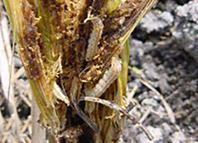
Pheromone Chemicals
Manufacturers of Pheromone Traps & Lures





Chilo partellus
(Spotted stalk borer)–is a moth in the family Crambidae. It is one of the most economically damaging pests, attacking all parts of the plant except the roots. Infestations can be detected by walking through crops looking for the characteristic physical appearance of a deteriorated host plant by the presence of deadhearts. Samples of infested stems can be cut open to find caterpillars and pupae.
Life cycle
Egg: The eggs are laid on the underside of a leaf near the midrib in 3-5 rows, in groups of 50-100. They are flattened,
ovoid and about 0.8 mm long. Hatching takes place after 7-10 days.
Larva: They are creamy pink with groups of dark spots along the back.The head capsule is brown.
When mature they are about 25 mm long. The larval period takes 28-35 days.
Pupa: Pupation takes place in a small chamber in the stem. The pupal period takes 7 10 days.
Adult: Adult moths have a wingspan of 20-30 mm. Males are smaller and darker than females. The forewings of males are pale brown.
The forewings of the females are much paler and the hind wings are almost white.
Host plants
Sorghum, Maize, Bulrush millet, Sugarcane, Rice.
Damage
Chilo partellus attacks several grass species which can be both cultivated and wild. Cultivated crop hosts include but are not limited to maize, sorghum, pearl millet, rice, and sugarcane. The first symptom of damage is the presence of irregular shaped pinholes or shot holes caused by early-instar larval feeding in the whorl. This can later convert to elongated lesions on the leaves. The infested plants appear ragged and deteriorated. The older larvae leave the whorl, break through and bore into the stem and reach the growing point. It is there that the larvae cut and cause the characteristic deadheart symptom. The damage due to the pest includes leaf feeding and subsequent destruction, extensive tunnels in stems and maize cobs, disruption in the nutrient flow, and the resultant death of the plant due to the puncture of the growing point.
ETL for Chilo partellus is 6-8 No’s of moths per trap per day.
Use 8-10 No’s Pheromone Traps per acre from 1-week crop stage for best results.
Trap canopy should be placed one feet above crop canopy to achieve optimum catch.
Recommended trap model :
Phero-Sensor™- SP or Phero-Sensor™ - BP traps
Recommended for: Sorghum, Maize, Bulrush millet, Sugarcane, Rice.
© 2020 Pheromone Chemicals. All Rights Reserved | Powered by: Raviteja Designs